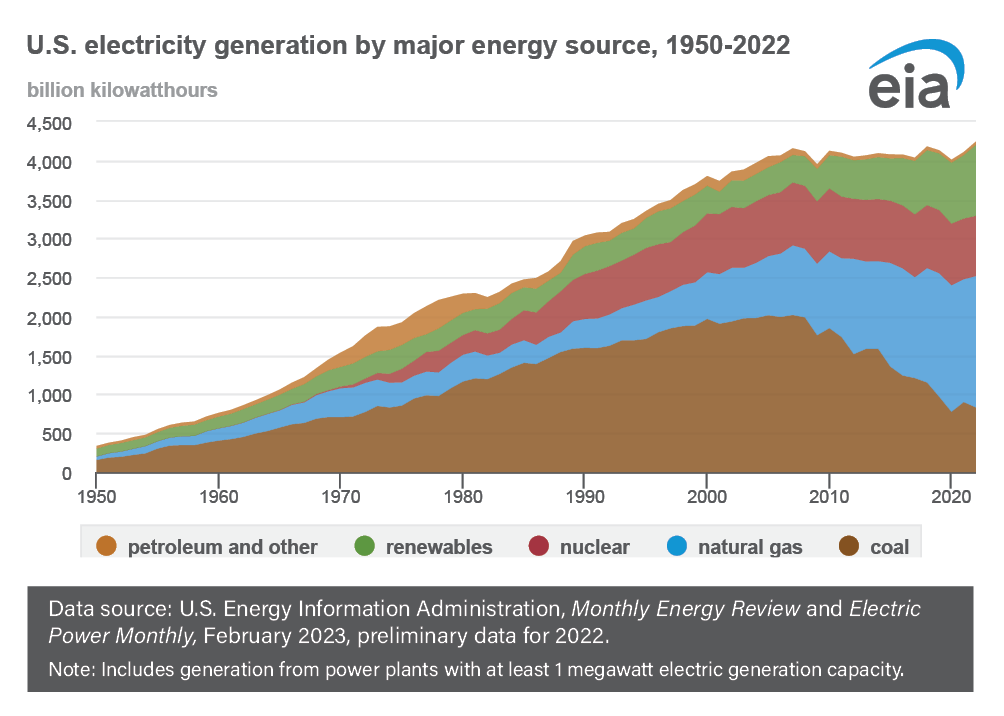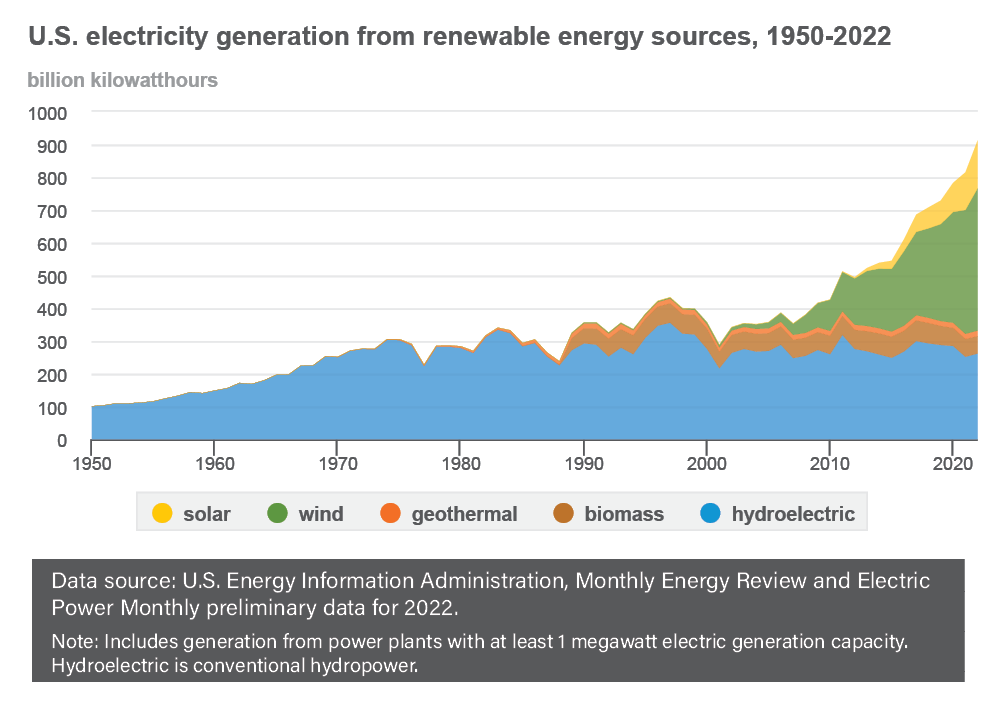
In last month’s article, I explained what the electrical grid is and how it functions. Specifically, I shared how power is generated and distributed in real-time to meet the demands you and I place on the grid at any given moment. In this month’s article, I’d like to dive deeper into the ways that power is produced, the differences between power production resources, and, more specifically, how power production in the Pacific Northwest (PNW) is so unique, special, and valuable.
First, it’s important to understand the difference between the capacity and output of a power plant. Simply put, capacity is the maximum amount of power a plant can produce at any given moment in time. Output is the amount of energy that plant actually produces over a given span of time. Consider KEC’s community solar array which has a capacity of 50 kilowatt (kW). The solar panels were designed to safely produce 50 kW of power when it was new at high noon on a perfectly cloudless day when the panels were clean. When the skies are cloudy, the panel produces somewhat less. In the early mornings and late evenings, it may produce 20 to 40 percent of its capacity. At night, nothing at all. On an annualized basis, the energy produced by this array is 15% of the total energy the array could theoretically produce if the sun never set. Contrast this with a nuclear plant that produces power near its capacity 24 hours a day 365 days a year. For this reason, the energy produced by a nuclear plant is around 90% of its theoretical maximum.
I need to bore you with one other concept. This is dispatchability. In short, a dispatchable plant is one that a dispatcher can rely on to match changes in the load you and I place on the grid. Solar panels and nuclear plants are not very dispatchable. Try as we may, we can’t control the sun or the clouds. Short of throwing a blanket over a solar panel, it will produce what the sun permits and won’t produce when it sets. Nuclear plants can be left on or turned off (scrammed)…but they dislike being in between. Other generation resources such as natural gas plants and hydroelectric dams are more controllable or dispatchable. Dispatchers can actively vary the amount of energy produced by such plants simply by increasing or decreasing the amount of natural gas flowing to them or the amount of water allowed to flow through the dam.
I’m not making a case that some power plants are good and others less so. They are all important. In fact, the diversity of fuels and production outputs helps keep the grid stable. However, it is important to recognize that the grid cannot function without dispatchable resources. Unfortunately, most dispatchable resources also emit carbon. Regardless of your views on the impact carbon has on our environment, it’s important to recognize that public policy has nearly ceased the development of these dispatchable resources over the last decade. That policy has instead compelled the development of carbon-free production that is not readily dispatchable. In fact, we have built so much of it that we suffer problems related to poor diversity…but that is the topic for another article.
Consider the following graphs which reflect the total amount of energy produced nationally by various types of power plants over the past several decades. The graph 1 reflects all forms of power plants. The green band of that graph reflects the total amount of energy produced by those plants that is considered “renewable.” The graph 2 shows in more detail the amount of energy produced by each type of renewable resource. The clear point here is that hydroelectric power has been and remains a mainstay of renewable energy production and also has the virtue of being dispatchable. The other two substantial forms of renewable resources are wind and solar. Neither of them benefits from dispatchability. It is with that backdrop that our story about how unique and special power supply in the PNW is, and how valuable a resource it is, begins.

In the early 1930’s, America was suffering through the Great Depression. Availability of electricity was scarce: those living in large metropolitan areas benefited from it while those in rural America did not. Electricity was also controlled by large utilities who exercised monopolistic powers to keep prices high. When seeking election to the Presidency, Franklin Delano Roosevelt (FDR) promised to break this cycle by constructing a hydroelectric dam on the Columbia River and making its output available “at-cost” to those living in the rural PNW. FDR was elected in 1932 and fulfilled his promise to those in our region with the completion of the Bonneville Dam in 1938. Europe was on the brink of war with Germany.
As World War II (WW2) began to rage in Europe and Indochina, the United States placed its industrial might into supplying its allies overseas. The power produced by the Bonneville Dam played a crucial role in this effort. The Japanese bombing of Pearl Harbor on December 7, 1941, brought the United States fully into the war. Other hydroelectric dams were planned and constructed along the Columbia, Snake, and Willamette Rivers to help power the industrial engine necessary to fight a war in two theaters. Grand Coulee Dam was completed in 1942, with Anderson Ranch Dam following in 1950, and McNary Dam in 1952. Big Cliff, Detroit, Hungry Horse, and Lookout Point Dams all followed a year later.

Veterans returning from war needed jobs. The industrial might of the PNW provided many opportunities. To help house them, a WW2 industrial housing complex in Vanport, Oregon, was repurposed. Tragically, the community was decimated by floodwaters resulting from brisk snowmelt in the Columbia River Basin. Oregon’s second-largest city at the time disappeared overnight leaving over 18,000 homeless. To ensure this never happened again, the U.S. government negotiated the Columbia River Treaty with Canada facilitating the construction of several additional ‘treaty dams’ whose purpose was specifically for flood control and power production and whose operations could be coordinated between the two governments. After all, all that water originated from the snowpack in Canada.
Collectively, these federal dams are now part of what is known as the Federal Columbia River Power System (FCRPS). The U.S. government created the Bonneville Power Administration (BPA) to deliver the power those dams produce to the market and to sell it at cost to those utilities that operate on a not-for-profit basis, such as KEC. In total, there are 31 federal dams having a collective capacity of 22,379 MW. They produce, on average, about 75,336,000,000 kWh of energy every year. You may also like to know that BPA also remarkets the power produced by other non-hydro federal projects which have subsequently been integrated into the FCRPS fleet. One of these is the Columbia Generating Station, the region’s only nuclear reactor.
The power produced by the FCRPS dams remains among the least expensive in the nation. It is also carbon free and renewable. Crucially, these resources are dispatchable. It is truly the envy of the world. And, it is in our backyard.
Unfortunately, the power these dams are able to produce is limited. Regional growth in demand for power has outpaced their production capacity. Foreseeing this problem, BPA allocated a portion of the output generated by the FCRPS resources to each of its utility customers on a pro-rata basis in 2012. Utilities with load below that amount could buy their full requirements from BPA at cost. Those with requirements that exceeded their allocation of the federal system would need to serve the incremental portion with other non-federal resources.
As a growing utility, this limitation affects us. Currently, 70 percent of our power comes from the FCRPS resources BPA remarkets to us at cost. The other 30 percent must be procured elsewhere. Between 2012 and 2020, the cost of non-federal power was at or marginally below the cost of power from BPA. This is no longer the case. Due to many factors including environmental policies, rapid growth and demand in the PNW, and the nation’s reluctance to construct dispatchable resources, the cost of non-federal power has skyrocketed. Within three years, the cooperative forecasts that the cost of purchasing the non-federal power it requires will outpace the cost of power purchased from BPA.
How KEC manages this and the impact these costs will place on rates will be the subject of my next article.
